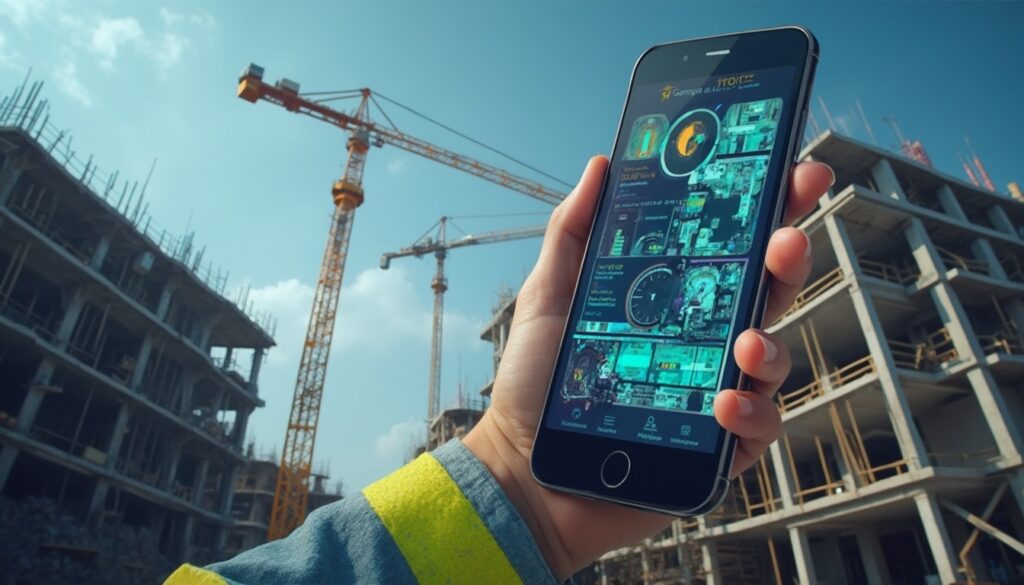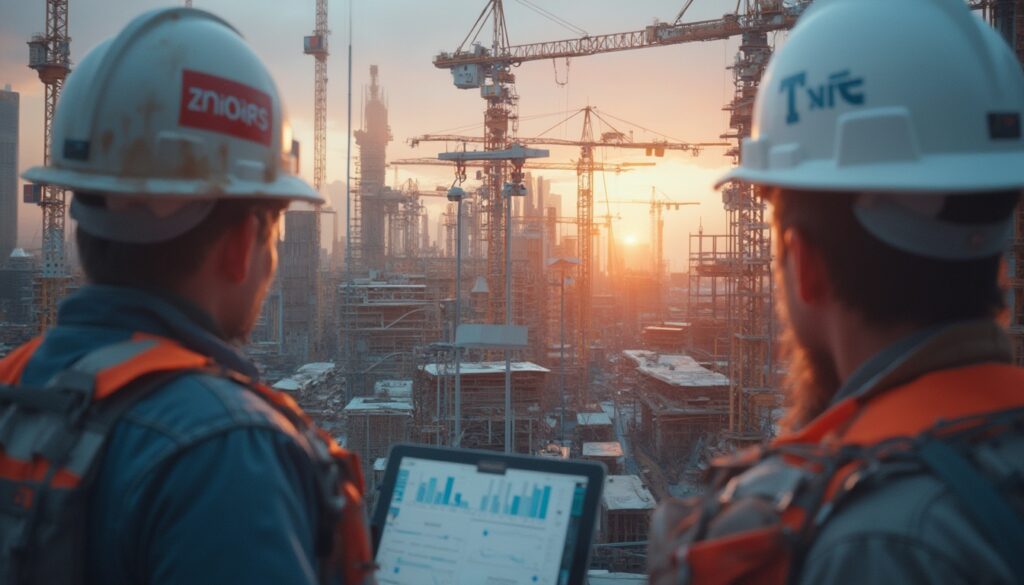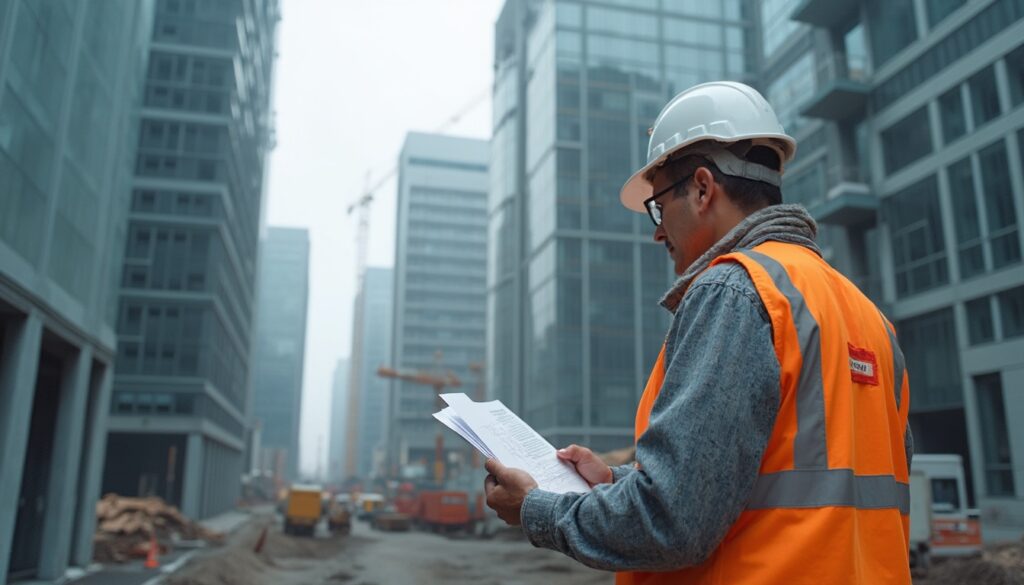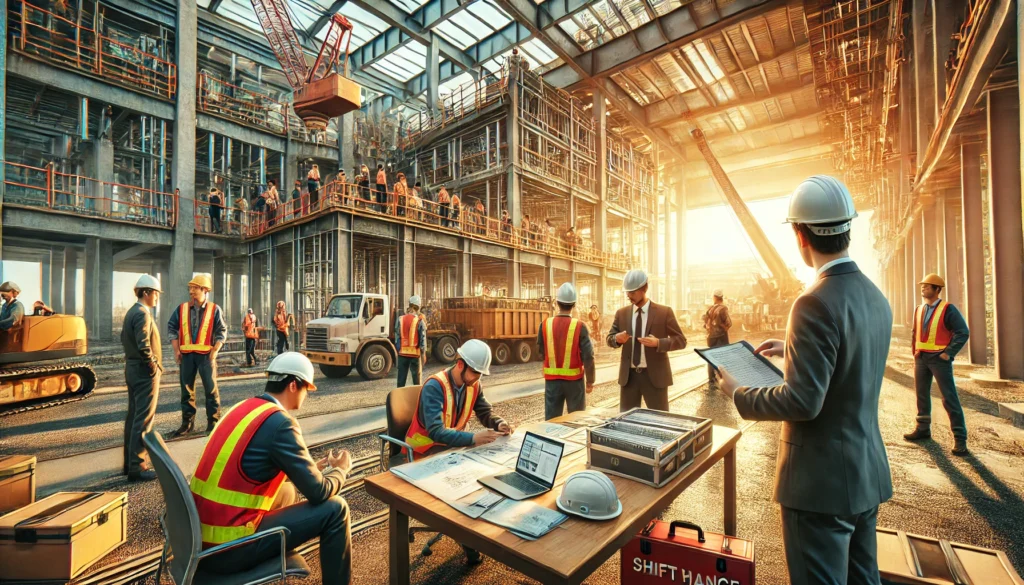HOAI Basic Investigation TGA: Laying the foundation for successful construction projects
To be honest, the Technical Building Equipment (TGA) – it’s a hefty challenge in modern construction projects, complex and often a real cost factor. That’s exactly why a crystal-clear foundation investigation for the TGA is incredibly important. It is the be-all and end-all, the foundation for everything that follows in the planning and construction process. If you’re not careful here, you risk planning errors, exploding costs, and annoying delays later on. As the first of the nine service phases (LPH 1) according to HOAI, it sets the course for your project to be technically top-notch, economically within budget, and completed on time. We at Valoon GmbH know from experience how crucial precise data collection and smooth communication from the very beginning are. Therefore, we want to give you some valuable insights in this article. Discover how you can HOAI Basic Investigation TGA put your construction project on the path to success right from the start and how our solutions can help significantly improve the flow of information between all parties involved. Just sign up for a no-obligation consultation – we are happy to work together to see how we can optimize your projects.
The Importance of Basic Investigation for TGA Projects
The basic investigation for the TGA is much more than just a formal point on the HOAI list. Consider it your most important step towards minimizing risks. Errors that occur here, right at the beginning, can snowball throughout the project, leading to significant additional costs and time losses. A detailed analysis of requirements, framework conditions, and all technical possibilities in the context of the HOAI Basic Investigation TGA ensures that all pieces of the Technical Building Equipment – from heating, ventilation, sanitary (HLS) to electrical and building automation – fit perfectly into the overall picture. The is indeed the basis for everything that follows.
Objective of the Article: Comprehensive Analysis and Action Recommendations
What can you expect in this article? We aim to provide you with a truly comprehensive analysis of the HOAI Basic Investigation TGA issues at hand. We will take a look at the core tasks, highlight the specific challenges in the TGA sector, and give you concrete action recommendations. You will learn how to optimally shape cooperation with specialist planners, which tools and checklists have proven helpful, and how to keep an eye on the economic viability of your project from the start. Our goal is to equip you with the knowledge to master this important phase confidently and sustainably enhance the quality of your construction projects. And of course, we will also take a look at how digital helpers like our office software for architects, can support this important process.Understanding LPH 1: Core Tasks and Delimitation of the HOAI Basic Investigation
The service phase 1 (LPH 1) of the HOAI, meaning the basic investigation, is not just the first step, but also one of the most important steps in every construction project – especially when it comes to the complex planning of Technical Building Equipment. What is it about? Quite simply: understanding the client’s requirements clearly, determining the project’s framework conditions, and thus creating a truly solid foundation for all the planning phases that follow. A precise HOAI Basic Investigation TGA is your key to setting the course for a successful project and preventing future errors in planning.
- Clear definition of project goals and client requirements.
- Comprehensive analysis of site conditions and specific needs.
- Preliminary examination of all relevant regulatory compliance and permits.
- Early involvement of competent TGA specialist planners.
Definition and Purpose of Service Phase 1
What exactly does the HOAI mean by basic investigation? It is about determining all the prerequisites we need to effectively solve the construction task. The purpose behind it is to gather all relevant information, carefully analyze it, and thus create a solid foundation for all further decisions. This involves clarifying project goals, the cost framework, your timeline expectations, and of course, the specific requirements for the TGA. A meticulous basic investigation for the TGA helps enormously in avoiding misunderstandings between you as the client and us as planners. This ensures that your project rolls in the right direction from the very beginning. Remember: The and thus the foundation for the entire construction process.
Ensuring a Smooth Project Flow through a Sound Basis
A truly sound basis, which we create through a detailed HOAI Basic Investigation TGA investigation, is worth its weight in gold for a smooth project flow. It allows us to detect potential problems early on and develop appropriate solutions. This might include the selection of the right TGA systems, adhering to energy efficiency regulations, or how we cleverly integrate TGA planning into the overall architecture. A solid basic investigation minimizes the risk of planning changes in later phases – and these often come with significant cost and time increases. It’s worth mentioning that a measurement app for sanitary can provide precise initial data.
Core Tasks and Responsibilities
What exactly falls under the core tasks of the HOAI Basic Investigation TGA? This involves clarifying the task at hand, analyzing the site, and determining the exact requirements. As planners, we carry a great responsibility here, as our assessments and recommendations set the course for the entire project. Close coordination with you as the client is crucial.
Clarifying the task with the client
A central point of this service phase is the intensive communication with you, the client. We need to capture and document your wishes, requirements, and goals very precisely. It’s about developing a mutual understanding of the project and clearly defining the specific needs in the area of TGA. These might include desired comfort standards, energy efficiency targets, budget guidelines, or operational demands. A clear task definition is the fundamental prerequisite for targeted planning and successful Projektmanagement für Installateure.
Site analysis and needs assessment
During the site analysis as part of the HOAI Basic Investigation TGA we take a close look at the local conditions: the building site, existing infrastructure, climatic conditions, and so forth. At the same time, we determine the specific need for TGA services for your planned project. This means thinking about how large the systems need to be, which technologies fit, and what future usage requirements we should consider. The results of these analyses flow directly into the conception of your TGA systems.
Preliminary examination of regulatory requirements
Another important aspect of the basic investigation for the TGA is the preliminary examination of all relevant regulatory requirements and permit prerequisites. Think of building regulations, environmental stipulations, fire safety regulations, or energy efficiency guidelines (like the GEG). By dealing with these framework conditions early on, we avoid later conflicts and ensure that planning goes hand in hand with all applicable regulations from the start. By the way, this is also important for the creation of revised documentation according to VOB .
Involvement of TGA Specialist Planners
The Technical Building Equipment is complex – no question about it. That’s why it’s often essential to bring specialized TGA planners on board early. These experts bring the necessary know-how to consider the specific requirements of the various TGA trades (heating, ventilation, sanitary, electrical, etc.) and develop an optimal solution for you. The selection and coordination of these specialist planners is also part of the HOAI Basic Investigation TGA and is an important component for the quality of planning.
Delimitation from Other Service Phases
As mentioned, the basic investigation (LPH 1) lays the foundation. The phases that follow build on it and make the planning progressively more concrete. It is important to clearly differentiate LPH 1 from the preliminary planning (LPH 2) and the design planning (LPH 3) to avoid overlaps or ambiguities.
Preliminary Planning (LPH 2)
Once the HOAI Basic Investigation TGA is completed, we move on to preliminary planning (LPH 2). In this phase, we develop an initial planning concept based on the collected fundamentals. This includes developing various solution variants, making an initial cost estimate, and coordinating with others involved in planning. While LPH 1 clarifies the question of “What” (What are the requirements?), LPH 2 focuses on “How” (How can we implement these requirements?). According to a % of the total fee.
Design Planning (LPH 3)
The design planning (LPH 3), in turn, builds on the preliminary planning. Here, it’s about working out a detailed and approval-ready design. The TGA systems are now concretely dimensioned, routing is determined, and all necessary calculations are performed. The results from this initial phase, such as defined quality standards and energy efficiency targets, play a significant role in ensuring that the final concept truly matches your original requirements.TGA Integration: Key to Optimized Basic Investigation
Technical Building Equipment (TGA) is truly a centerpiece of modern construction projects. Early consideration of it, coupled with the right expertise during the HOAI Basic Investigation TGA is absolutely crucial for the functionality, economic viability, and sustainability of a building. If TGA planning is not properly integrated here, it can lead to significant issues during the project’s progress – and we want to avoid that.
Specific Requirements of Technical Building Equipment
The TGA is quite a broad field with a variety of trades, each having their very specific requirements. A successful HOAI Basic Investigation TGA must keep this complexity in mind from the very beginning and set the course for integrated planning. The illustrate this well; they include wastewater, water and gas systems, heat supply systems, air handling systems, and high voltage systems.
Consideration of heating, ventilation, sanitary, electrical, etc.
In this first service phase, we need to systematically capture and evaluate the requirements of all relevant TGA trades – namely heating, ventilation, sanitary (HLS), cooling, electrical, building automation, and lift systems – . This means clarifying usage requirements, comfort expectations, energy efficiency targets, and budget guidelines for each individual trade. It is super important to recognize the dependencies and interfaces between the trades early on and to consider them in planning. Only then can we ensure optimal overall functionality. A precise. Das heißt, wir klären Nutzungsanforderungen, Komfortansprüche, Energieeffizienzziele und Budgetvorgaben für jedes einzelne Gewerk. Es ist super wichtig, die Abhängigkeiten und Schnittstellen zwischen den Gewerken frühzeitig zu erkennen und in der Planung zu berücksichtigen. Nur so können wir eine optimale Gesamtfunktion sicherstellen. Eine präzise planning of air ducts using measurement software is just one small example of how detailed the work can get.
Integration of TGA Planning into the Overall Process
Isolating the TGA won’t get us anywhere. The HOAI Basic Investigation TGA requires close synergy with the object planning and other specialist planning. Only in this way can we ensure that TGA systems fit optimally into the building and avoid conflicts with other components or uses.
Early Involvement of TGA Experts
Bringing an experienced TGA specialist engineer on board early, is a critical factor for the success of the basic investigation of the TGA. These experts bring the necessary specialist knowledge to evaluate complex technical requirements, develop innovative solutions, and assess the economic viability of various systems. Their expertise helps us avoid misguided decisions and set the course for a sustainable and efficient TGA solution. The coordination of these experts is a core task that can be supported through optimized construction planning techniques .
Coordination with Architects and Other Specialist Planners
Die HOAI Basic Investigation TGA requires an intensive coordination and alignment with the architect and other involved specialist planners (e.g., structural engineers, fire safety experts). We need to define interfaces, clarify responsibilities, and develop a mutual understanding of project goals. Open and transparent communication is crucial to minimize friction losses and ensure truly integral planning. Digital tools for project communication, like those we offer at Valoon GmbH, can significantly simplify this process.
System Analysis as a Key Element
A comprehensive system analysis is a cornerstone of the basic investigation for the TGA. It helps us examine various solution approaches for the TGA and select the variant that best suits your project. This goes beyond merely determining needs and means that we proactively engage with alternative systems and technologies.
Technical feasibility, economic viability, and environmental compatibility
As part of the system analysis during the HOAI Basic Investigation TGA we evaluate potential TGA systems in detail regarding their technical feasibility, economic viability, and environmental compatibility. We not only consider investment costs but also life cycle costs (for operation, maintenance, disposal). Aspects like energy efficiency, resource conservation, and CO2 emissions are playing an increasingly important role and must naturally be included in the assessment. The goal is to find a TGA solution that is both economically viable and ecologically sound.
Proactive Examination of Alternative Systems
This phase should not just rely on tried-and-tested standard solutions. We find it important to also proactively explore alternative and innovative TGA systems. This might include using renewable energy, intelligent building automation, or new materials. An open approach and readiness to explore new paths can help realize future-proof and particularly efficient TGA solutions. The analysis should also consider integration into BIM software to optimize construction projects .Clearly Defining Basic and Additional Services in the TGA Basic Investigation
The Fee Scale for Architects and Engineers (HOAI) doesn’t always make it easy for us, but it clearly distinguishes between basic services and additional services in the context of the HOAI Basic Investigation TGA – and in all other service phases as well. A clear delimitation and definition of these service components are super important for transparent contract design and thus also for fair fee negotiations. This is especially relevant for TGA projects, as specific surveys and planning services are often required.
Definition and Delimitation
Understanding where exactly the difference between basic and additional services lies is fundamental when we want to correctly apply the HOAI and commission planning services in the TGA sector. This creates clarity about what exactly is being done and what it costs.
Basic Services: Standard Tasks for Architects/Engineers
Basic services are those services that, according to HOAI, are generally required for the proper completion of an order . For this service phase, you will find these detailed in Annex 15 (Technical Equipment). They encompass the fundamental steps to clarify the task and determine planning requirements. Compensation for these basic services is regulated in the fee tables of the HOAI – even if, since 2021, price binding has been lifted and fees are negotiable. The .
Additional Services: Individually Agreed, Extra Tasks
Additional services go beyond the scope of basic services and are not simply included in the fee as a flat rate. They must be agreed upon separately and also compensated separately. In the area of HOAI Basic Investigation TGA these could be, for example, detailed demand planning, economic feasibility assessments for specific systems, or extensive surveys. Whether and to what extent additional services are necessary depends heavily on your project’s specific requirements.
Examples of Basic Services in the TGA Basic Investigation
Section 55 HOAI in conjunction with Annex 15 establishes the basic services for technical equipment. For service phase 1, that is the basic investigation, the typical components are:
- Consultation on overall service and investigation requirements: This is about clarifying the task based on your specifications or needs assessment and conducting an on-site visit. Comprehensive consultation is crucial for a successful basic investigation of the TGA.
- Formulation of decision aids for the selection of other parties involved in planning professionally: We assist you as the client in selecting other specialist engineers, for example, for specific areas of TGA or for energy consulting.
- Summary, explanation, and documentation of results: All findings, analyses, and decisions of the basic investigation must be carefully documented and presented to you. This creates transparency and a comprehensible basis for further planning steps of the HOAI Basic Investigation TGA.
Examples of Additional Services in the TGA Basic Investigation
Beyond basic services, various additional services may be necessary in the context of the basic investigation for TGA to meet your project’s specific requirements:
- Demand planning and creation of function and room programs: A detailed analysis and definition of the functional requirements for the TGA systems as well as the creation of space programs based on them. This is particularly important for complex uses such as laboratory buildings or hospitals.
- Creation of energy concepts and sustainability analyses: The development of specific energy concepts, for example involving renewable energies or conducting sustainability assessments (e.g. DGNB, LEED). Such services are of great significance for a future-oriented HOAI Basic Investigation TGA approach.
- Conducting site and soil investigations: Although this is often more associated with the object planner, specific investigations for the TGA may be necessary, for example, regarding geothermal energy usage.
- Creation of feasibility studies: A detailed examination of whether specific TGA solutions or concepts are technically and economically feasible. This may also include checking integration into existing systems, which may require an accurate local construction supervision according to HOAI 2013 for existing structures.
Clearly agreeing on which services are basic services and which are additional services is crucial for transparent collaboration and cost control in this important initial phase.Efficiency Enhancement through Checklists and Digital Tools in the TGA Basic Investigation
A structured and efficient execution of the HOAI Basic Investigation TGA is, as we have seen, the key to project success. The use of checklists and modern software solutions can make a huge difference – for quality assurance, time savings, and better communication. Especially in complex TGA planning, these tools help us keep track and minimize errors.
- Efficiency Enhancement: Faster processes and reduced manual efforts.
- Improved accuracy: Minimization of errors in data collection.
- Transparent communication: Easy access to current project information for everyone.
- Seamless documentation: Traceable logging of all steps and decisions.
The Importance of Checklists for Quality Assurance
Checklists are a simple yet incredibly effective tool to ensure that everything runs completely and correctly during the HOAI Basic Investigation TGA . They help us not forget any important aspect and establish standardized processes.
Ensuring completeness and avoiding errors
At this initial stage, we need to gather, analyze, and document a wealth of information. A detailed checklist that truly covers all relevant points – from clarifying your client requests to site analysis to preliminary examination of regulatory compliance – minimizes the risk of overlooking important details. This is particularly important, as omissions in this early phase often have far-reaching consequences. A checklist for service phases of the HOAI TGA is a good starting point.
Recommendations for Creating Individual Checklists
Standardized checklists provide a good basis, of course. But we recommend customizing them for each project to truly meet the specific requirements. This increases the relevance and usefulness of the checklist in your TGA basic investigation.
Adapting to specific project requirements
Every construction project is unique. That’s why it’s so valuable to adapt standard checklists for the HOAI basic investigation TGA to the specific circumstances. Consider, for example, the type of building (residential, commercial, industrial), how complex the TGA is, regional peculiarities, and of course, your specific wishes as the client. A customized checklist ensures that all project-relevant aspects are covered and serves as a guiding thread through service phase 1.
Use of Software and Apps for Support
Digitalization opens up a variety of opportunities to make this phase more efficient and transparent. Modern software solutions and mobile apps can significantly support us planners and you as clients.
BauMaster, Compa, and other construction management tools
Software solutions like BauMaster or Compa, which were also mentioned in the Research Input, can HOAI Basic Investigation TGA simplify the process considerably. Such tools allow a central collection and management of all project-related information, transparent communication among all parties involved, and seamless documentation. Features like digital task management, cloud-based project storage, and mobile data collection (for example, via a messenger integration like the one we offer at Valoon GmbH) significantly optimize workflows and reduce administrative efforts. Using a bill of materials software can also be advantageous in later phases, which we are laying the groundwork for here.
Digitization of Documentation and Communication
A comprehensive digitization of documentation and communication is another key to becoming more efficient here. Instead of struggling with piles of paper and confusing email chains, digital platforms allow for quick and easy access to all relevant data and decisions. This promotes transparency, avoids misunderstandings, and greatly facilitates collaboration within the project team. Our platform at Valoon GmbH aims precisely at this: optimizing communication and project management through simplified data collection and processing. This is a huge advantage, especially in the HOAI Basic Investigation TGA .
Key Benefits of Digital Support
When we use digital tools in this phase, it offers a whole range of advantages:
- Efficiency Enhancement: Faster data collection, automated processes and reduced manual efforts save you time and costs.
- Improved accuracy: Digital data collection minimizes transfer errors and ensures more accurate foundations for further planning.
- Transparent communication: All parties have access to current information, which significantly facilitates collaboration and decision-making.
- Seamless documentation: All steps, decisions, and changes are digitally recorded. This increases traceability and gives you legal certainty.
Keeping costs in check: Efficiency and fees of the TGA preliminary investigation
Of course, economic aspects also play a HOAI Basic Investigation TGA crucial role. Even if the fee component for this service phase may initially seem relatively small, it is precisely here that the course is set for the overall costs of your project. Therefore, careful budgeting and a clear understanding of fee calculation are essential.
The fee component of the preliminary investigation (about 2-3%)
According to HOAI, the preliminary investigation (LPH 1) usually accounts for approximately 2-3% of the total fee for the planning services of the Technical Building Equipment. For TGA services according to § 55 HOAI, the share for the preliminary investigation is even explicitly set in § 56 at only 2% of the total remuneration for TGA services. However, this seemingly small share should not mislead us about the strategic importance of this phase .
Importance of efficient resource utilization
Considering the limited fee component, it becomes clear: an efficient use of resources in the HOAI preliminary investigation TGA is extremely important. As planners, we need to gather, analyze, and evaluate a wealth of information in a short time. Using standardized processes, checklists, and digital tools, as we offer at Valoon GmbH with a focus on simple data collection, can greatly help optimize the effort while ensuring the quality of the results. Because a precise preliminary investigation for the TGA avoids costly rework in later phases.
Room for negotiation and individual agreements
Since the HOAI amendment in 2021, the strict price binding of the HOAI is a thing of the past. This means for you and us: Fees for architect and engineering services, also for the HOAI Basic Investigation TGA, are now freely negotiable. This opens up spaces but also requires a crystal-clear definition of services.
Abolition of the price binding of HOAI since 2021
The fact that the binding minimum and maximum rates of HOAI 2021 have been overturned has led to more flexibility in fee structuring. As clients and planners, we can now make individual agreements, which better meet the specific requirements of your project and the scope of services for this first phase. Nevertheless, it is still advisable to refer to the HOAI fee tables as a guideline and clearly define the services – just to exclude misunderstandings from the outset. A shows quite well the percentage shares of the service phases.
Cost framework and budgeting
A crucial outcome of the HOAI Basic Investigation TGA is the creation of an initial cost framework. This serves as a basis for further planning and budgeting of your project and must naturally consider the specific cost factors of the TGA.
Creation of an initial cost framework as a basis for further planning
Even in service phase 1, a rough cost framework for TGA measures should be put on the table. This is based on the first insights into the assignment, your user requirements, and the technical possibilities. This cost framework serves you as the client as an initial guideline and helps evaluate the economic feasibility of the project. A realistic assessment at this phase is absolutely critical to avoid later budget overruns. Software like Compa is also mentioned in research as a tool for creating cost frameworks.
Consideration of TGA-specific cost factors
When we create the cost framework as part of the preliminary investigation for the TGA, we must carefully consider TGA-specific cost factors.These include not only the pure acquisition costs for systems and components but also installation costs, expenses for integration into the building, commissioning, and possibly initial estimates of future operating costs. The complexity of TGA and the diversity of possible systems require sound expertise and a truly detailed examination.Success factors: Best practices for an optimal TGA preliminary investigation
A successful HOAI Basic Investigation TGA, as we have often emphasized, is based on proven practices and a clear strategy. If we pay attention to some central success factors, we as planners and you as the builder can significantly enhance the quality of this crucial first service phase. Thus, we jointly set the course for a successful overall project. Optimizing the information flow, as we strive for at Valoon GmbH, is a very important piece of the puzzle.
- Open and continuous communication with the client to clarify all TGA requirements.
- Careful selection of experienced TGA specialists and experts.
- Comprehensive documentation of all collected information, assumptions, and decisions.
- Use of BIM for improved coordination and visualization already in the early phase.
Early and transparent communication with the client
The basis of every successful HOAI Basic Investigation TGA is open, honest, and continuous communication with you as the client. Only if we fully understand your wishes, requirements, and perhaps also concerns, can we establish a targeted planning.
Clarification of TGA requirements and service goals
Ein intensive dialogue with you as the client is essential to precisely define the specific requirements for the Technical Building Equipment. It’s not just about functional aspects but also about qualitative goals like energy efficiency, sustainability, comfort, and ease of use. During this phase, we must clearly document these requirements and establish them as binding service goals for further planning. As already mentioned, the and must therefore be executed with particular care.
Careful selection of specialists and experts
The complexity of TGA usually requires specialized knowledge. Selecting the right experts is therefore a truly critical step in the HOAI Basic Investigation TGA.
Consideration of experience and expertise
When selecting TGA specialists and other experts, this should always be done based on proven experience and expertise. Reference projects, professional qualifications, and a deep understanding of the specific challenges of your construction project are important criteria. By involving these experts early in this first phase, we ensure that their know-how optimally flows into the planning process and that we can develop innovative, economical solutions for you. This is also important for the later onsite construction supervision according to HOAI 2013. Detailed documentation of all information and decisions
Detaillierte Dokumentation aller Informationen und Entscheidungen
A comprehensive and traceable documentation is the backbone of every professional planning service – especially in the information-intensive HOAI Basic Investigation TGA.
Avoidance of misunderstandings and legal security
All information we collect as part of the preliminary investigation for the TGA, all assumptions made, discussed solution approaches, and final decisions must be documented carefully and comprehensibly. This not only serves to avoid misunderstandings among project participants but also provides us with legal protection. Clear documentation creates transparency and forms a reliable basis for all subsequent service phases. Digital tools, like our office software for architects, can significantly simplify and structure this process.
Use of BIM (Building Information Modeling) for coordination
Building Information Modeling (BIM) offers immense potential to improve planning quality and coordination – and that already in the HOAI Basic Investigation TGA.
Ensuring smooth collaboration between specialists
The use of BIM can significantly enhance the coordination and collaboration between architects, TGA specialists, and other participants.When everyone works on a common digital building model, we can identify and avoid interface conflicts early on. Even in this phase, BIM can help us spatially visualize initial concepts and understand the implications of various TGA systems on the overall building. The optimization of construction projects through BIM software is an important trend that we should keep an eye on.
Important aspects for a successful preliminary investigation
In addition to the points mentioned, there are a few more aspects that contribute to success:
- Allocate sufficient time: The preliminary investigation should not be conducted under time pressure. A thorough analysis simply takes its time. According to – we should take this to heart.
- Define clear responsibilities: Who is responsible for which task in the preliminary investigation? Clear responsibilities avoid duplicated work and loss of information.
- Engage in risk management: Potential risks (technical, economic, timely) should be identified and assessed as early as possible.
Overcoming challenges: Approaches to the TGA preliminary investigation
Die HOAI Basic Investigation TGA is, we don’t want to hide this, a demanding process that can certainly be associated with various challenges. A proactive approach to these potential difficulties and the use of suitable solutions are crucial to ensuring the quality and efficiency of this vital first service phase. The simplification of data collection and processing, as we strive for at Valoon GmbH, can make an important contribution to overcoming these hurdles.
Complexity of TGA planning
The Technical Building Equipment is one of the most complex trades in the entire construction industry. This complexity naturally demands high requirements of the HOAI Basic Investigation TGA and requires very specific expertise.
Specific expertise required
Planning heating, ventilation, sanitary, cooling, electrical, and building control systems – all this requires in-depth specialized knowledge and a lot of experience.Even at this phase, we must lay the foundations for these systems correctly. Our solution: The early involvement of qualified TGA engineers and specialists is absolutely essential here. These experts can analyze the specific requirements, propose suitable systems, and assess the technical feasibility. The highlight the variety of areas we need to focus on.
Coordination of various trades
The TGA consists of numerous individual trades that need to be optimally coordinated with each other. Coordinating these trades is a central challenge in the HOAI Basic Investigation TGA.
BIM as a solution for smooth collaboration
Coordinating the various TGA trades with each other, and also with the architecture and other planning disciplines – that can often be tricky. Interface conflicts and information loss can quickly result from that. Our solution here: The use of Building Information Modeling (BIM) can significantly improve the coordination.A shared digital building model enables a transparent and collaborative planning process, where we can identify and resolve conflicts at an early stage. This is a core aspect for a successful preliminary investigation for TGA and also for the later Optimization of construction projects using BIM software..
Budget constraints
Construction projects are often subject to strict budget constraints – you surely know this. Adhering to these constraints while also ensuring high TGA quality is a real challenge for this first service phase.
Efficient planning and cost control
Developing a TGA solution that is both functionally convincing and keeps within the budget requires a careful planning and continuous cost control.Our approach: Already in the HOAI Basic Investigation TGA we should evaluate different system variants also from an economic perspective (keyword: lifecycle cost assessment). A transparent presentation of costs and close coordination with you as the client are crucial here. Digital tools for cost tracking, like those used for the creation of specifications can support us well here.
Changes in the course of the project
Requirements and conditions can change during a project – this is almost the norm. Flexibility and adaptability are therefore also required in this phase.
Flexibility and adaptability
Changes from your side, new technical developments, or unforeseen circumstances may necessitate adjustments to the original planning. Our solution: An agile project management and a flexible planning structure can help us respond to changes in the course of the project without losing sight of the goals of the preliminary investigation for the TGA. Of course, good documentation of all changes and their impacts is essential. Our software at Valoon GmbH also supports you by simplifying data collection and information flow, helping to manage such changes better.Conclusion: Securing optimal TGA projects through precise preliminary investigation
Phew, that was quite a lot of input on the HOAI Basic Investigation TGA! But one thing should be clear: it is much more than just a formal first service phase – it is the absolute foundation for the entire success of your construction project in the area of Technical Building Equipment. If we work carefully, comprehensively, and proactively here, we minimize risks, prevent cost explosions, and ensure that the TGA systems are optimally tailored to the needs of users and the requirements of the building. The quality of this early phase has direct implications for every single planning and execution step that follows.
The central importance of the HOAI preliminary investigation for TGA projects
If we want to be specific: The intensity and accuracy of the HOAI preliminary investigation TGA directly correlate with the quality, cost-effectiveness, and schedule adherence of your overall project. Early clarification of all relevant aspects – from your user requirements to technical possibilities to economic and ecological conditions – creates a solid basis for truly informed decisions. Involving all important stakeholders, especially experienced TGA specialists, and communicating transparently is essential. Attention to the specific requirements of TGA, as beautifully illustrated in the, is of great importance.
Future developments and trends
The construction industry, and especially the area of TGA, is constantly changing. New technologies, changing legal requirements, and a growing awareness of sustainability shape future developments and, of course, also influence this first service phase.
Digitization and automation
Digitization, especially through Building Information Modeling (BIM), will certainly continue to change the HOAI Basic Investigation TGA . Automated analyses, simulations, and improved data availability enable us to make even more precise plans and collaborate more efficiently. Tools that, like our solutions at Valoon GmbH, focus on the simplification of data collection and processing will play a key role here. Using a measurement app for sanitary or a duct measurement program are already good examples of such digital helpers.
Sustainability and energy efficiency
The themes of sustainability and energy efficiency are becoming increasingly important in TGA planning, which we feel every day. This phase must increasingly take ecological aspects into account – think of the use of renewable energies, reducing the CO2 footprint, and selecting environmentally friendly materials. Developing holistic energy concepts will become one of our core tasks. This naturally requires even closer integration with the optimized construction planning overall.
Recommendations for architects and engineers
So you can successfully tackle the challenges of the HOAI Basic Investigation TGA and seize the opportunities of future developments, we would like to emphasize a few points for you as architects and engineers:
- Invest enough time and resources into the preliminary investigation. A thorough analysis always pays off in the long run.
- Focus on open and continuous communication with the client and all project participants. Talk to each other!
- Utilize the potentials of digitization and implement modern planning and communication tools. It’s worth it!
- Continuously educate yourself, to stay updated on new technologies, regulations, and trends in the TGA sector.
- Clearly and distinctly define the scope of services and fees, especially when it comes to basic and special services.
We at Valoon GmbH want to help you optimize your communication and project management processes, especially in the construction industry. By simplifying data collection and processing and improving the information flow between field service and office, we help you make this important phase and all subsequent project phases more efficient and successful. Discover how our software solutions, like the office software for architects or tools for the Projektmanagement für Installateure, can make your work easier. Just contact us for a personalized consultation – we look forward to elevating your construction projects to the next level together!
What exactly is the TGA preliminary investigation according to HOAI (LPH 1)?
The preliminary investigation (LPH 1) for Technical Building Equipment (TGA) is the first planning phase according to HOAI.Here, the assignment is clarified, project goals are defined, and all relevant information as well as conditions for TGA planning (heating, ventilation, sanitary, electrical, etc.) are compiled. It forms the basis for all subsequent planning steps..
Why is a careful preliminary investigation for TGA projects so important?
A careful TGA preliminary investigation is crucial for risk minimization.Errors or gaps in this early phase can later lead to significant planning errors, cost increases, and construction delays. It ensures that the TGA is optimally tailored to the needs and the building.
What core tasks belong to the HOAI preliminary investigation TGA?
The core tasks include the clarification of the assignment with the client, the site analysis, the needs assessment for all TGA trades, a preliminary review of regulatory requirements, and the inclusion or selection of TGA specialists.A comprehensive documentation of the results is also central.
What is the difference between basic services and special services in the TGA preliminary investigation?
Basic services are standard tasks that are generally required for proper project fulfillment according to HOAI (e.g., consultation, clarification of the assignment). Special services go beyond that (e.g., detailed needs planning, creating specific energy concepts) and must be agreed upon separately and compensated. How much does the TGA preliminary investigation approximately cost?
Wie viel kostet die Grundlagenermittlung TGA ungefähr?
The fee component for the preliminary investigation (LPH 1) in the area of TGA amounts to about 2% of the total fee for TGA planning services according to HOAI § 56. Since 2021, fees are, however, für die TGA-Planungsleistungen. Seit 2021 sind Honorare jedoch freely negotiable,the HOAI rates serve as a guideline.
How can digital tools like Valoon support the TGA preliminary investigation?
Digital tools like the Valoon platform can significantly simplify the TGA preliminary investigation by digitalizing the data collection on-site (e.g., via messenger),allowing a central project repository and improving the information flow between all parties involved.This reduces errors, saves time, and ensures comprehensive documentation.
What role does the early involvement of TGA specialists play?
The early involvement of TGA specialists in the preliminary investigation is critical for planning quality.They bring the necessary specialized knowledge to assess complex technical requirements, develop innovative and economical solutions, and avoid erroneous decisions.
What are typical challenges in the TGA preliminary investigation?
Typical challenges include the high complexity of TGA trades, coordination with other planning participants, compliance with budget constraints, and managing changes in the course of the project. Approaches to solutions include the use of experts, BIM, and digital tools as well as flexible planning.








